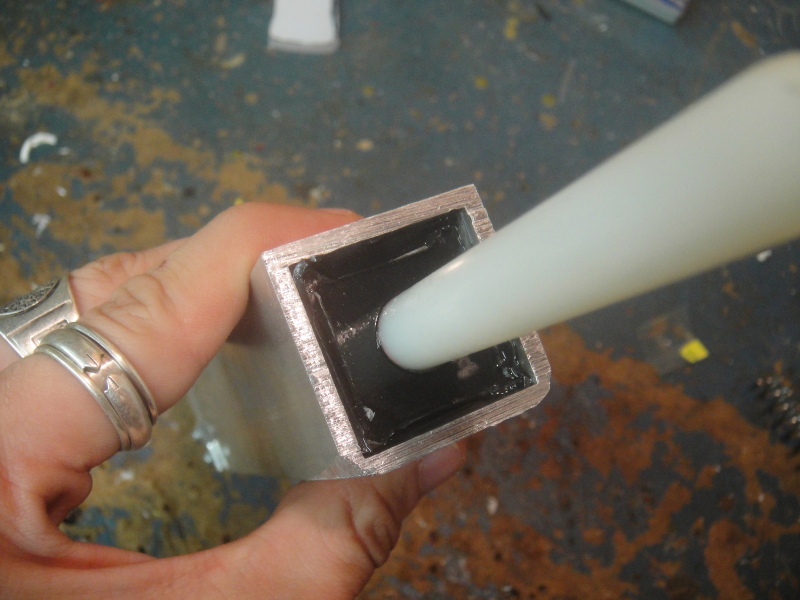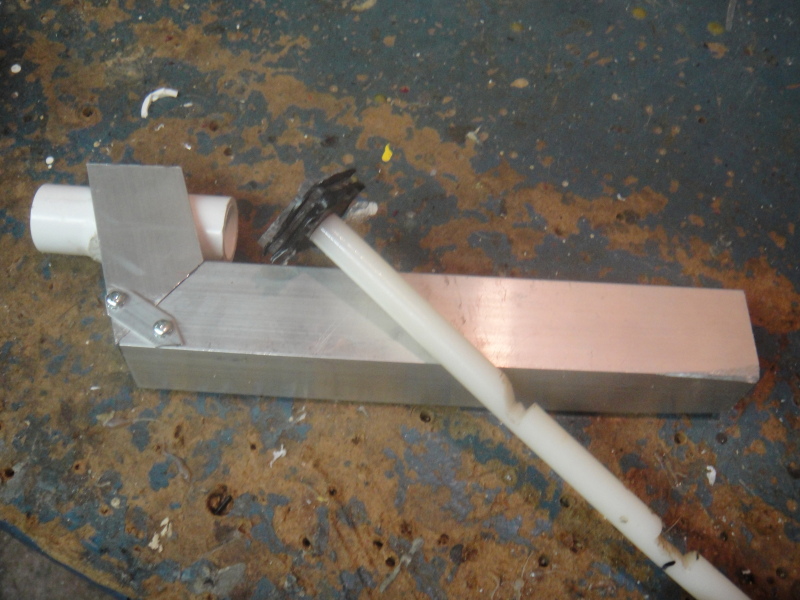
Plunger tube shape significance?
#1

Posted 30 November 2017 - 10:33 AM
Like, gun A and gun B both have very silly proportions. A has a radius 1cm, but a whole 100cm in length, while B is just 1cm long but 100cm wide. (Whoever made them was obviously trying to make a point.) Since both clock at 100cm^2, do they perform equally? And would a 10x10cm perform better? Most importantly, why?
#2

Posted 30 November 2017 - 10:52 AM
3.14*1^2*100=3,410
3.14*50^2*1=7,850
So the fatter one has just over double the volume.
But otherwise, yes it does matter, and yes there is a point where it gets too wide. You have the seal as both a weak point and friction point and spring limitations to contend with. Aggregate experimenation over the years indicates that our 1-1/4 Sch. 40 PVC is actually a really good size for the factors we have to contend with, with 1 200 PSI PVC also being useful and assorted aluminum tubes that approximate the PVCs plunger volume (~17.3 cubic inches with 8 pull we usually get).
Youll note few springers built using larger PVC sizes, IIRC Ive seeb/heard of a few SNAPs and similar built with 2, but never much beyond that.
#3

Posted 30 November 2017 - 10:56 AM
I get the friction and leak points (both come down to circumference), but could you elaborate on the spring limitations?
#4

Posted 30 November 2017 - 12:18 PM
*facepalm* i fail math yet again.
I get the friction and leak points (both come down to circumference), but could you elaborate on the spring limitations?
Pressure and flow rate are what drives the darts through the barrel and out on to the field. Also, there is a practical limit to the force that a person can apply to a plunger to prime the mechanism. Say, 10 lbs. If your plunger face has an area of 1.0 in^2, then the absolute maximum pressure that the plunger can build is (force)/(area) = 10PSI, though that is far above what it will actually build. The the plunger displaces 1.0", then the volume is 1.0in.^3. If the plunger face has an area of 2.0in^2, but the same spring, the pressure drops to 5PSI, but the volume doubles to 2.0in.^3. So great, that now drops the maximum force that is transferred to the dart from 7.85 pounds to 3.925 pounds, but allows the that pressure to be maintained for a longer duration. Which is better? In this case, probably the wider plunger, but you'll need a longer barrel.
[15:51] <+Rhadamanthys> titties
[15:51] <+jakejagan> titties
[15:51] <+Lucian> boobs
[15:51] <+Gears> titties
[15:51] <@Draconis> Titties.
[15:52] <+Noodle> why is this so hard?
#5

Posted 30 November 2017 - 12:30 PM
#6

Posted 30 November 2017 - 12:56 PM
You need a stronger spring to keep equal pressure, all else being equal.Well, that is helpful, but not quite the question: the question would be, if I went for 2 inches area but shortened the chamber to keep volume at 1 inch^3, what would happen?
The spring constraints are, in addition to physical capabilities of a person as Draconis points out, that we only have so many springs readily available to choose from. Youd need a good reason to go for a custom job over a [k26] in a 1-1/4 PVC (or eq.) plunger setup when those can be had for $3 or so and deliver ~200-220 FPS with the right barrel.
Edited by Meaker VI, 30 November 2017 - 12:58 PM.
#7

Posted 30 November 2017 - 02:45 PM
There is a friction, restriction, mass, and velocity issue when scaling upwards in plunger diameter.
1. The larger the ID of the plunger tube, the more friction the seal has. So you have to transition to atypical seal types that are much lower friction. KaneTheMediocre's solution of using yarn is clever and meets this criteria perfectly.
2. The ID of the barrel is a source of restriction with being able to pump a higher volume ratio of air quickly. The end of the plunger tube being a huge ratio of area transition can throttle plunger velocity since it starts to starve. You scale plunger diameter up more readily when the bore diameter is also scaling up.
3. The larger the plunger head gets, the more mass it has. The more mass it has, the harder it is for a spring of a certain load to accelerate it. So you end up having to scale the spring load to match.
4. There's a trade-off and a dynamic relationship between how fast you can get the plunger going, and how much volume it has to work with in the time frame in which it is accelerating. If you lower the velocity, you lower the potential peak impulse of pressure that the plunger can reach. This pressure impulse determines what pressure level the plunger can reach even in the event of there being leaks present. And you basically have to think of the dart as being a slow leak.
#8

Posted 01 December 2017 - 05:25 AM
Where can I find that?KaneTheMediocre's solution of using yarn is clever and meets this criteria perfectly.
So if I'm getting this, going from a wide chamber to a narrow barrel limits the speed at which air can get out of tge chamber, causing resistance for the spring?2. The ID of the barrel is a source of restriction with being able to pump a higher volume ratio of air quickly. The end of the plunger tube being a huge ratio of area transition can throttle plunger velocity since it starts to starve. You scale plunger diameter up more readily when the bore diameter is also scaling up.
Ok, I don't quite get that at all, past the core principle. Could you elaborate?4. There's a trade-off and a dynamic relationship between how fast you can get the plunger going, and how much volume it has to work with in the time frame in which it is accelerating. If you lower the velocity, you lower the potential peak impulse of pressure that the plunger can reach. This pressure impulse determines what pressure level the plunger can reach even in the event of there being leaks present. And you basically have to think of the dart as being a slow leak.
#9

Posted 01 December 2017 - 07:53 AM
1. Check out any of the "HAMP" links in the homemades directory
2. Correct
3. Spring Plunger performance is dependent upon how fast the plunger can accelerate. This acceleration gets translated into a short burst of pressure. Heavier plunger heads take more time for the spring to get moving, so you need to keep the mass of the plunger to a minimum.
#10

Posted 01 December 2017 - 11:57 AM
3. I get that, it was point #4 that I needed elaborating on!
Still, I am slowly making sense! Thanks bunches!
Edited by Xhosant, 01 December 2017 - 12:17 PM.
#11

Posted 01 December 2017 - 11:52 PM
3. I get that, it was point #4 that I needed elaborating on!
4. There's a trade-off and a dynamic relationship between how fast you can get the plunger going, and how much volume it has to work with in the time frame in which it is accelerating.
Larger Plunger, more volume = More mass = Slower plunger :: Smaller plunger, less volume = less mass = faster plunger
You want to move as much air volume as quickly as possible to get pressure, which is a dynamically-opposed goal: Moving more air means doing it more slowly.
If you lower the velocity, you lower the potential peak impulse of pressure that the plunger can reach.
Slower plunger = lower max pressure in the powertrain.
This pressure impulse determines what pressure level the plunger can reach even in the event of there being leaks present. And you basically have to think of the dart as being a slow leak.
The max pressure determines how much pressure you can put behind the dart.
Slug can correct me if my summary is incorrect.
#12

Posted 02 December 2017 - 02:39 AM
Slower plunger = lower max pressure in the powertrain.
Could a blast disk help with that?
#13

Posted 02 December 2017 - 03:04 AM
#14

Posted 02 December 2017 - 09:40 AM
Could a blast disk help with that?
Probably, but then youve got a one-shot blaster and you might as well do a pneumatic.
On another note, has anyone derived a math formula describing the whole spring-pushes-plunger-pushes-air-pushes-dart process? I figure it would answer a whole lot of future questions automatically.
Edit your first post rather than double post in a short time period.
Boltsniper and DOOM did some theoretical calculations. One of them may even have the formula youre looking for, but I may be confusing what Im thinking is it with some other formula they came up with. Dont have time to go looking ATM.
#15

Posted 02 December 2017 - 10:22 AM
Probably, but then youve got a one-shot blaster and you might as well do a pneumatic.
Unless you're loading shells, like the FAR.
Edit your first post rather than double post in a short time period.
Boltsniper and DOOM did some theoretical calculations. One of them may even have the formula youre looking for, but I may be confusing what Im thinking is it with some other formula they came up with. Dont have time to go looking ATM.
Sorry, will do. I know Boltsniper's Barrel Length Formula, but no idea where to look elsewhere. Anyone know?
#16

Posted 03 December 2017 - 09:44 PM
man I love having intellectual discussions here,
That being said this thread reminded me of something else,
how come we don't have like, square plunger tubes? Is it just because it's odd to make?
I'm Van, the weird kid with a box
Triggered as fuck and ready to gun you down
#NoBarrelTapsNoMercy
#GoFastGoFurious
"Stone Cold Operator of Death" -Clownie
#17

Posted 03 December 2017 - 11:08 PM
how come we don't have like, square plunger tubes? Is it just because it's odd to make?
And because it wouldn't work. Look around at any piston; have you ever seen any square seals? Circular sections, having maximum area for their perimeter, distribute force evenly around that perimeter when sealed. Squares et.al. do not.
I think NERF has one square-plungered weirdo. It's basically a jolt, and it uses that shape to get a narrower profile than would be practical with a circular PT. IIRC.
#18

Posted 05 December 2017 - 01:33 AM
And because it wouldn't work. Look around at any piston; have you ever seen any square seals? Circular sections, having maximum area for their perimeter, distribute force evenly around that perimeter when sealed. Squares et.al. do not.
I think NERF has one square-plungered weirdo. It's basically a jolt, and it uses that shape to get a narrower profile than would be practical with a circular PT. IIRC.
Split and I wanted to maximize the plunger volume in a Crossbow shell without having the shell bow out and he ended up making a square setup for it (it was needlessly expensive and stupid but fun to discuss). It apparently sealed okay but the project was never finished and it never got posted, but here's the King Bow's internals.
Unholy Three: DUPLUM SCRTA, DUPLUM PROBLEMA (2009)
But Zeke guns tend to be like proofs by contradiction
Theoretically solid but actually non-constructive
Rnbw Cln
#19

Posted 16 January 2018 - 05:58 PM
Larger plunger tubes aren't always better, not only for the reasons above, but because for a given spring load, you can't create as much pressure in the plunger tube and barrel. For example, if you have 10kg of force from the spring, then a 1.5" ID plunger tube could produce a maximum pressure of 0.86 bar, while a 1" ID plunger tube can create 1.94 bar. I'm working on a program to simulate springer performance, the numbers it's getting right now are a bit higher than real world numbers, but it's saying that the optimal plunger tube inside diameter is about 30mm.
#20

Posted 16 January 2018 - 06:22 PM
0 user(s) are reading this topic
0 members, 0 guests, 0 anonymous users




















